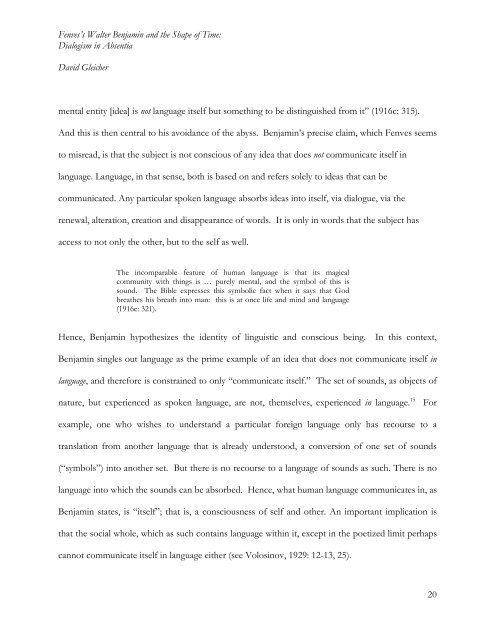Peter Fenves's Walter Benjamin and the Shape ... - Adelphi University
Peter Fenves's Walter Benjamin and the Shape ... - Adelphi University
Peter Fenves's Walter Benjamin and the Shape ... - Adelphi University
Create successful ePaper yourself
Turn your PDF publications into a flip-book with our unique Google optimized e-Paper software.
Fenves’s <strong>Walter</strong> <strong>Benjamin</strong> <strong>and</strong> <strong>the</strong> <strong>Shape</strong> of Time:<br />
Dialogism in Absentia<br />
David Gleicher<br />
mental entity [idea] is not language itself but something to be distinguished from it” (1916c: 315).<br />
And this is <strong>the</strong>n central to his avoidance of <strong>the</strong> abyss. <strong>Benjamin</strong>’s precise claim, which Fenves seems<br />
to misread, is that <strong>the</strong> subject is not conscious of any idea that does not communicate itself in<br />
language. Language, in that sense, both is based on <strong>and</strong> refers solely to ideas that can be<br />
communicated. Any particular spoken language absorbs ideas into itself, via dialogue, via <strong>the</strong><br />
renewal, alteration, creation <strong>and</strong> disappearance of words. It is only in words that <strong>the</strong> subject has<br />
access to not only <strong>the</strong> o<strong>the</strong>r, but to <strong>the</strong> self as well.<br />
The incomparable feature of human language is that its magical<br />
community with things is … purely mental, <strong>and</strong> <strong>the</strong> symbol of this is<br />
sound. The Bible expresses this symbolic fact when it says that God<br />
brea<strong>the</strong>s his breath into man: this is at once life <strong>and</strong> mind <strong>and</strong> language<br />
(1916c: 321).<br />
Hence, <strong>Benjamin</strong> hypo<strong>the</strong>sizes <strong>the</strong> identity of linguistic <strong>and</strong> conscious being. In this context,<br />
<strong>Benjamin</strong> singles out language as <strong>the</strong> prime example of an idea that does not communicate itself in<br />
language, <strong>and</strong> <strong>the</strong>refore is constrained to only “communicate itself.” The set of sounds, as objects of<br />
nature, but experienced as spoken language, are not, <strong>the</strong>mselves, experienced in language. 15 For<br />
example, one who wishes to underst<strong>and</strong> a particular foreign language only has recourse to a<br />
translation from ano<strong>the</strong>r language that is already understood, a conversion of one set of sounds<br />
(“symbols”) into ano<strong>the</strong>r set. But <strong>the</strong>re is no recourse to a language of sounds as such. There is no<br />
language into which <strong>the</strong> sounds can be absorbed. Hence, what human language communicates in, as<br />
<strong>Benjamin</strong> states, is “itself”; that is, a consciousness of self <strong>and</strong> o<strong>the</strong>r. An important implication is<br />
that <strong>the</strong> social whole, which as such contains language within it, except in <strong>the</strong> poetized limit perhaps<br />
cannot communicate itself in language ei<strong>the</strong>r (see Volosinov, 1929: 12-13, 25).<br />
20


